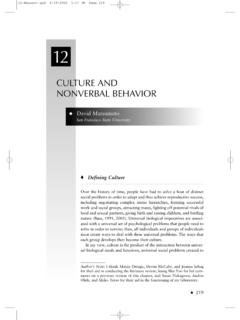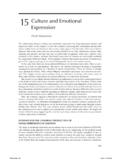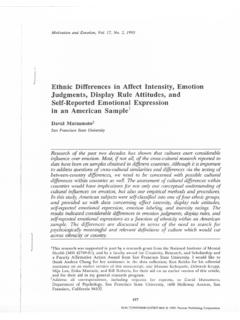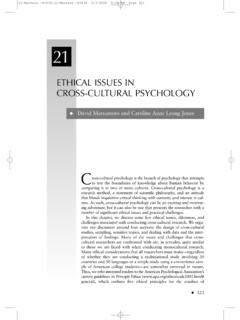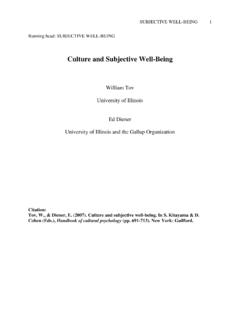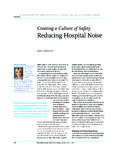Transcription of Culture and self: An empirical assessment of Markusand ...
1 Asian Journal of Social Psychology (1999) 2: 289 310. Culture and self : an empirical assessment of Markus and Kitayama's theory of independent and interdependent self - construals David Matsumoto San Francisco State University In this paper, I critically evaluate the logic underlying Markus and Kitayama's (1991) theory of independent and interdependent self - construals , and examine the evidence that directly tests its major assumptions. On the basis of my review of the studies they cite, and literature from three other sources, I conclude that the evidence severely challenges the validity of their theoretical framework for explaining observed national differences in psychological phenomena. I offer some ideas about alternative methodologies for research in this important area of psychology that may aid in developing and testing theories of Culture and self in the future.
2 In the , the squeaky wheel gets the grease''; in Japan, the nail that sticks up gets pounded down''. Markus and Kitayama (1991) contend that anecdotes like these symbolize meaningful and important cultural differences between the and Japan, and North American/European and almost all other cultures. These differences are the basis for their theory of independent and interdependent self - construals , which is arguably one of the most influential works in the past decade in Culture and psychology. Its import and implications are far-reaching, its popularity and usage widespread. Like all theories, we need to objectively evaluate it in terms of its assumptions and empirical support. Despite its popularity, to my knowledge no work to date has explicated its assumptions, nor objectively reviewed the available evidence in support of them.
3 This paper does so. First, I review the theory, highlight major aspects of it, and describe its basic logic. Second, I identify its major assumptions, and evaluate those assumptions in relation to the evidence that has been suggested as supportive of their theory. My evaluation suggests that no study supports their contentions, because none tests the basic logic underlying their theory. Third, I review three other types of studies that directly test the assumptions in their theory. This evidence also suggests that there is little, if any, empirical support for them. Finally, I. discuss the implications of this evidence for their theory, and for future work in this area. independent and interdependent selves, and their impact on cross-cultural psychology A brief review of the theory, and its basic logic Markus and Kitayama's (1991) well-known theory is based on the premise that Blackwell Publishers Ltd with the Asian Association of Social Psychology and the Japanese Group Dynamics Association 1999.
4 290 David Matsumoto For many cultures of the world, the Western notion of the self as an entity containing significant dispositional attributes, is simply not an adequate description of self -hood.. In many Western cultures, there is a faith in the inherent separateness of distinct persons.. In contrast, many non-Western cultures insist .. on the fundamental connectedness of human beings to each other. (pp. 226 227). According to their theory, people of Western, primarily individualistic cultures have independent self - construals , where the person is a bounded, unique, more or less integrated motivational and cognitive universe, a dynamic center of awareness, emotion, judgment and action organized into a distinctive whole and set contrastively both against other such wholes and against a social and natural background'' (p.)
5 226). People of many non-Western, primarily Asian, cultures, however, have interdependent self - construals , which feature the person not as separate from the social context, but as more connected and less differentiated from others. People are motivated to find a way to fit in with relevant others, to fulfill and create obligation, and in general to become part of various interpersonal relationships. The significant features of the self are found in the interdependent and more public components of the self '' (p. 227). The concept of independent versus interdependent selves is similar to concepts of self and human nature proposed by others, including Freud's (1930/1961) union with others versus egoistic happiness, Angyal's (1951) surrender and autonomy, Balint's (1959).
6 Ocnophilic and philobatic tendencies, Bakan's (1966) communion and agency, Bowen's (1966) togetherness and individuality, Bowlby's (1969) attachment and separation, Franz and White's (1991) individuation and attachment, Stewart and Malley's (1987) interpersonal relatedness and self -definition, and Slavin and Kriegman's (1992) mutualistic and individualistic urges (all cited in Guisinger & Blatt, 1994). The difference between self as typically conceptualized in mainstream American psychology and other cultures has been noted by others, including Doi (1973), Kim & Berry (1993), and Heelas & Lock (1981). Sampson (1988) referred to the self in mainstream approaches as self -contained individualism, contrasting it with ensembled individualism, where the boundary between self and others is less sharply drawn and others are part of oneself.
7 While their theory was originally published in 1991, Markus and Kitayama's presentation of its basic tenets has changed little since ( , see Fiske, Kitayama, Markus, & Nisbett, 1998; Kitayama, Markus, Matsumoto, & Norasakkunkit, 1997; Markus & Kitayama, 1994a, 1994b, 1995, 1998). In explaining American Japanese differences in self -enhancement versus self -criticism, for instance, Kitayama, Markus, Matsumoto, and Norasakkunkit (1997) stated: Western, especially European American middle-class cultures are organized according to meanings and practices that promote the independence and autonomy of a self that is separate from other similar selves and from social context.. In contrast, many Asian cultures do not highlight the explicit separation of each individual.
8 (p. 1247). Likewise, Markus and Kitayama (1998) contrasted the Western view of the independent self with the non-Western, specifically Japan, China, Korea, Southeast Asia, South America, and Africa, view of interdependent self , suggesting that the East Asian model of individuality comes with a commitment that is tied to the recognition that the person is also a social being ( , an entity that is made meaningful within a larger social context). Personalities result as people engage in particular roles with specific other people. Behavior is actively responsive to Blackwell Publishers Ltd with the Asian Association of Social Psychology and the Japanese Group Dynamics Association 1999. Culture and self 291. and incorporates the demands of others.
9 Within the Asian interdependent model of the person, the integration of social role and distinctiveness is accomplished by a sort of conditioning of individual distinctiveness on a certain relationship or social position. Individual differences ( , diligent or lazy) are defined within a semantic framework or model of human action that corresponds to a pertinent social position or role.. This conditionality of person description on a social context reflects the appreciation of the relational nature of any behavior in the Asian model of person. (pp. 72 73). To be sure, the Markus and Kitayama (1991) position does not make assumptions about complete homogeneity within cultural groups. Fiske et al. (1998), for example, were careful to point out that there may be considerable differences within the two cultural groups.
10 Markus and Kitayama (1994a) have also indicated that they do not assume that all individuals in a given cultural group are alike. Rather, they suggested that members of a given group are more likely to have been exposed to and have operated within a given cultural frame than members of the contrasting group, and thus members of the same cultural group may share some [italics in the original] similar behavioral tendencies or patterns'' (p. 99). These writings, and many others ( , Kitayama & Karasawa, 1995; Kitayama &. Markus, 1994; Kitayama, Markus, and Matsumoto, 1995; Markus, Kitayama, & Heiman, 1996; Markus, Kitayama, & VandenBos, 1996; Markus, Mullaly, and Kitayama, 1997), contain a basic logic that can be easily extrapolated, and is outlined in Figure 1 (top).



